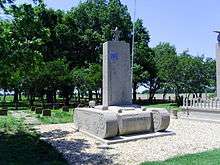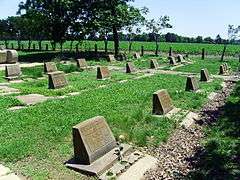Rohwer War Relocation Center
|
Rohwer Relocation Center Cemetery | |
|
Rohwer Memorial Cemetery | |
  | |
| Location | Desha County, Arkansas, United States |
|---|---|
| Nearest city | Rohwer, Arkansas |
| Coordinates | 33°45′58.67″N 91°16′48.57″W / 33.7662972°N 91.2801583°WCoordinates: 33°45′58.67″N 91°16′48.57″W / 33.7662972°N 91.2801583°W |
| Architect | Kaneo Fujioka and Kay Horisawa |
| NRHP Reference # | 92001882 |
| Significant dates | |
| Added to NRHP | July 06, 1992[1] |
| Designated NHL | July 6, 1992[1] |
The Rohwer War Relocation Center was a World War II Japanese American internment camp located in rural southeastern Arkansas, in Desha County. It was in operation from September 18, 1942 until November 30, 1945, and held as many as 8,475 Japanese Americans forcibly evacuated from California.[2] The Rohwer War Relocation Center Cemetery is located here, and was declared a National Historic Landmark in 1992.[1]
History
The 10,161 acres (4,112 ha) of land on which Rohwer was built had been purchased by the Farm Security Administration from tax-delinquent landowners in the 1930s. It remained largely abandoned until the War Relocation Authority, which oversaw the World War II incarceration program, took it over in 1942. (Then-Governor Homer Adkins initially opposed the WRA's proposal to build Rohwer and its neighbor, Jerome, in Arkansas, but relented after ensuring that the Japanese American inmates would be kept by armed white guards and would be removed from the state at the end of the war.) The Linebarger-Senne Construction Company was contracted to build the camp at a cost of $4.8 million and worked under the supervision of the Army Corps of Engineers. The land was heavily forested and swampy due to its proximity to the Mississippi River, only 5 miles to the east, which made the clearing and draining necessary to build on the site a difficult and slow-going task. The camp was still under construction when the first inmates began to arrive, but ultimately there were administrative offices, schools, a hospital, and 36 residential blocks, each with twelve 20' by 120' barracks divided into several "apartments" and communal dining and sanitary facilities, all contained within a guarded barbed-wire fence.[2]
The architect of the camp was Edward F. Neild of Shreveport, Louisiana, who also designed the camp at Jerome.[3]

Rohwer opened on September 18, 1942 and reached a peak population of 8,475 by March 1943, most of whom had come from Los Angeles or the San Joaquin Valley in California. A large portion of Rohwer inmates were school-age children, and about 2,000 students attended the camp's schools, which were opened on November 9, 1942 after some delay. Adults took jobs with the administration, hospital, schools, and mess halls, in addition to agricultural work or labor details outside camp. With only 500 acres (200 ha) of the site used for residences and other buildings, the remainder of Rohwer's land was used to grow over 100 agricultural products, which supplemented the inmates' food rations (kept to a bare minimum of 37 cents a day per inmate to avoid feeding rumors that the WRA was "coddling" Japanese Americans).[2]
In 1943, the WRA required all adults in Rohwer and the other camps to submit to a series of questions. Officially, it was presented as the registration process to obtain clearance to leave camp for work or school — and it was initially distributed only to the citizen Nisei who were eligible for leave, before being extended to the first-generation Issei — but administrators soon began to focus instead on assessing the loyalty of imprisoned Japanese Americans. The "loyalty questionnaire," as it came to be known, created anger and confusion because of two questions that asked Japanese Americans to volunteer for military service (despite their mistreatment by the government and the army) and to forswear their allegiance to the Emperor of Japan (despite the fact that many had never held such allegiance in the first place). The loyalty questionnaire and subsequent recruitment efforts proved especially unpopular in Jerome, which was located only 27 miles south of Rohwer. Only 2 percent of eligible men in Jerome (and in Rohwer) enlisted, and 2,147 others, a quarter of Jerome's population, were designated "disloyal" after giving unfavorable responses to the questionnaire and transferred to the "segregation center" at Tule Lake, California.[4] The decline in population, combined with earlier unrest over working conditions in the camp, led Jerome authorities to close the camp at the end of June 1944, and a significant number of former Jerome inmates were then transferred to Rohwer.
Rohwer was the last WRA camp to close, besides the Tule Lake Segregation Center, on November 30, 1945.[2]
Rohwer today

The largest remaining structure is the high school gymnasium/auditorium, which was added to and was in service with the local school before it closed in July 2004. The tallest structure is the smokestack from the hospital incinerator. Neither of these is marked in any way to indicate historical significance. The rail line used to bring internees and supplies to the camp remains, though it is apparently abandoned. Some of the rails date back to World War II and before. This rail line also served the Jerome War Relocation Center, which was located 30 miles (48.3 km) southwest of Rohwer.
Various building foundations, walkways, culverts and other improvements are still visible and some are still in use by the local residents. Trees planted by residents have grown tall.
The camp cemetery survives as the only site still identified as having been part of the internment center. It was listed as a National Historic Landmark in 1992.[1][5] It has a monument to Japanese American war dead from the camp, and also a monument to those who died at the camp. The camp site was listed on the National Register of Historic Places in 1974.[1] A tank-shaped memorial, made of reinforced concrete, guards the cemetery, commemorating Japanese Americans who fought for the United States at Anzio and elsewhere in Italy and France during World War II. Thirty-one who came from Rohwer died in action, and their names are inscribed on the memorial, as well as a later memorial raised nearby.[6]
In its National Historic Landmark summary on the Rohwer Relocation Center Cemetery, the National Park Service writes:
Rohwer Relocation Camp was constructed in the late summer and early fall of 1942 as a result of Executive Order 9066 (February 19, 1942). Under this order, over 110,000 Japanese Americans and their immigrant parents were forcibly removed from the three Pacific Coast States—California, Oregon, and Washington. In all, ten camps were established in desolate sites, all chosen for their distance from the Pacific Coast. Over 10,000 evacuees passed through Rohwer during its existence, and over two thirds of these were American citizens. The monuments found within the camp's cemetery are perhaps the most poignant record of this time."[1]
In its summary on the Rohwer Relocation Center Cemetery, the National Park Service indicates that the cemetery's condition is threatened due to deterioration of the grave markers and monuments, but that ownership of the site is unclear.[1] Deterioration is visible in photographs of the site. Deterioration is discussed in a report from the National Park Service to the President.[6]
The cemetery is located 0.5 miles (0.8 km) west of State Route 1, approximately 12 miles (19.3 km) northeast of McGehee, Arkansas. Signs identify the graded road which goes from the highway to the cemetery, where there is room to park automobiles.
Heritage Site
The Rohwer War Relocation Center site is now an Arkansas State University Heritage Site,[7] and features a memorial, the camp cemetery, interpretive panels and audio kiosks.[8]
The Japanese American Internment Museum opened in nearby McGehee, Arkansas in 2013 and serves as the history museum and unofficial visitor center for the Rohwer War Relocation Center. Exhibits include a film, oral histories, photographs and personal artifacts of the internees.[9]
Shooting of residents by a civilian at Rohwer
M.C. Brown, a tenant farmer on horseback on his way home from deer hunting, came across some Japanese Americans from the Rohwer camp, on a work detail in the woods. He fired his gun, and one of the Japanese American men was struck in the hip by a pellet while another was wounded in the calf of the leg. The Japanese Americans were working in the woods under the supervision of a government engineer when the shooting occurred.[10]
Notable internees

- Ruth Asawa (1926-2013), Japanese American sculptor
- Takayo Fischer (born 1932), American stage, film and TV actress; also interned at Jerome
- Aiko Herzig-Yoshinaga (born 1925), political activist; also interned at Manzanar and Jerome
- Jim Ishida (born 1943), actor best known for his role as T. Fujitsu, Marty McFly's future boss in Back to the Future Part II in 1989
- Janice Mirikitani (born 1941), current poet laureate of San Francisco; co-founded with her husband, the Rev. Cecil Williams, the Glide Foundation (Glide Memorial Church is featured in the Will Smith film The Pursuit of Happiness). Glide empowers San Francisco's disadvantaged members of society through extensive outreach and advocacy efforts.
- Henry Sugimoto (1900–1990), Japanese-born artist; also interned at Jerome
- George Takei (born 1937), activist, author, and actor best known as Captain Hikaru Sulu from Star Trek (1966–69). Since his parents refused to take a vow and did not "pass" the loyalty questionnaire, the family was later transferred to Tule Lake War Relocation Center.[11]
- Taitetsu Unno (1930-2014), Buddhist scholar, lecturer, and author; also interned at the Tule Lake War Relocation Center
- Grayce Uyehara (1919-2014), Japanese-American social worker and activist
See also
- Japanese American Internment
- Japanese American Internment Museum
- Other camps:
- List of National Historic Landmarks in Arkansas
- National Register of Historic Places listings in Desha County, Arkansas
References
- 1 2 3 4 5 6 7 "Rohwer Relocation Center Cemetery". National Historic Landmark summary listing. National Park Service. 2007-09-26. Retrieved 2008-07-09.
- 1 2 3 4 Niiya, Brian. "Rohwer" Densho Encyclopedia. Retrieved 2014-05-29.
- ↑ "Neild, Edward F.". lahisatory.org. Retrieved April 18, 2015.
- ↑ Niiya, Brian. "Jerome" Densho Encyclopedia. Retrieved 2014-08-07.
- ↑ "National Register of Historic Places Registration" (PDF). National Park Service. 1991-06-25. Retrieved 2008-07-09.
- 1 2 "Report to the President: Japanese American Internment Sites Preservation: Rohwer Relocation Center". National Park Service. Retrieved 2007-09-27.
- ↑ "Official site". Arkansas State University Heritage Sites. Retrieved 21 September 2015.
- ↑ McGhee Chamber announcement
- ↑ "Museum". Rohwer Japanese American Relocation Center. Retrieved 21 September 2015.
- ↑ Vickers, Ruth Petway (Summer 1951). "Japanese-American Relocation". The Arkansas Historical Quarterly. Arkansas Historical Association. 10 (2): 175. JSTOR 40018477.
- ↑ "George Takei: Biography". georgetakei.com. 2007-09-26. Retrieved 2008-07-09.
Notes
External links
| Wikimedia Commons has media related to Rowher War Relocation Center. |
- Rohwer War Relocation Center - official site
- John Howard, "John Yoshido in Arkansas, 1943." Southern Spaces, 2 October 2008. http://southernspaces.org/2008/john-yoshida-arkansas-1943
- "National Register of Historic Places Registration" (PDF). National Park Service. 1991-06-25. Retrieved 2008-07-09. - Rohwer Relocation Center Memorial Cemetery—Accompanying 54 photos of camp ruins, memorial, and cemetery from 1990
- Historic American Landscapes Survey (HALS) No. AR-4, "Rohwer Relocation Center Memorial Cemetery, Arkansas Highway 1, Rohwer, Desha County, AR", 6 measured drawings, 37 data pages
- Brian Niiya. "Rohwer," Densho Encyclopedia, 2014.
- Patricia Wakida. "Rohwer Outpost (newspaper)," Densho Encyclopedia, 2014.

